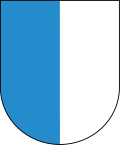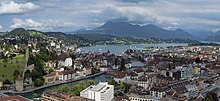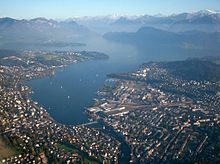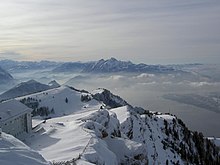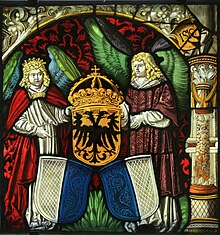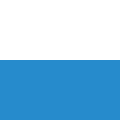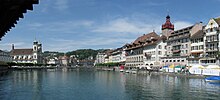Lucerne
| Lucerne | |
|---|---|
| State : |
|
| Canton : |
|
| Constituency : | Lucerne city |
| BFS no. : | 1061 |
| Postal code : | 6003–6006 Lucerne 6014–6015 Lucerne |
| UN / LOCODE : | CH LZN (Lucerne) CH LIT (Littau) CH RBU (Reussbühl) |
| Coordinates : | 665 892 / 211 591 |
| Height : | 436 m above sea level M. |
| Height range : | 419–1123 m above sea level M. |
| Area : | 29.11 km² |
| Residents: | 81,691 (December 31, 2018) |
| Population density : | 2806 inhabitants per km² |
|
Proportion of foreigners : (residents without citizenship ) |
24.2% (December 31, 2,015) |
| Unemployment rate : | 3.1% (April 30, 2,016) |
| City President : | Beat Züsli ( SP ) |
| Website: | www.stadtluzern.ch |
|
Reuss, Chapel Bridge with water tower, Jesuit Church, City Hall and Rathausquai |
|
| Location of the municipality | |
(Swiss German Lozärn [loˈtsæːrn] ,French Lucerne, Italian Lucerna, Rhaeto-Romanic ) is atown,municipalityandcapitalof theSwisscanton ofthe same name. It also forms theLucerne City constituency.
Lucerne is the social and cultural center of Central Switzerland . In the field of education, it is, among other things, the seat of the University of Lucerne , the University of Education Lucerne and the University of Lucerne . Occasions with supraregional appeal are, for example, the Lucerne Carnival and the Lucerne Festival . Lucerne is an important tourist destination in Switzerland, on the one hand because of its location on Lake Lucerne and its proximity to the Alps and on the other hand thanks to sights such as the Chapel Bridge and the Swiss Museum of Transport .
geography
The city of Lucerne is located on the northwestern bank of Lake Lucerne at the outflow of the Reuss . The Reuss divides the city into the old town and the new town . The Chapel Bridge with the Water Tower and the Spreuer Bridge connect the old and new towns. The Bürgenstock exclave also belongs to Lucerne . The location between the lake and the Pilatus and Rigi mountains is particularly picturesque and favored the development of Lucerne as a foreign city and an early tourism stronghold from 1840 onwards.
The highest point in the municipality is the summit of the Bürgenstock in the Bürgenstock exclave with a height of 1127.8 m above sea level. M. The lowest point is at the Rotsee on 419 m above sea level. M.
The area of the urban area is 29.1 km² , of which 44.2% is settlement area , 30.2% is agricultural zones and 23.7% is forest. 2.0% are unproductive space.
climate
| Lucerne 1981–2010 | ||||||||||||||||||||||||||||||||||||||||||||||||
|---|---|---|---|---|---|---|---|---|---|---|---|---|---|---|---|---|---|---|---|---|---|---|---|---|---|---|---|---|---|---|---|---|---|---|---|---|---|---|---|---|---|---|---|---|---|---|---|---|
| Climate diagram | ||||||||||||||||||||||||||||||||||||||||||||||||
| ||||||||||||||||||||||||||||||||||||||||||||||||
|
Average monthly temperatures and precipitation for Lucerne 1981–2010
|
||||||||||||||||||||||||||||||||||||||||||||||||||||||||||||||||||||||||||||||||||||||||||||||||||||||||||||||||||||||||||||||||||||||||||||||||||||||||||||||||||||||||||||||||||||
The maximum value of the average duration of sunshine in January was reached in 2020 with 98.5 hours. This broke the previous record of 1999 (86.7 hours).
City structure
Since 2014, the city of Lucerne has been divided into 2 city districts, 6 urban districts, 26 quarters and 132 small quarters. The city districts 01 to 10 are on the right bank, the city districts 11 to 19 on the left bank of the Lucerne Bay (northwest arm of the cross funnel), seen from the lake. The urban district of Littau also includes the district of the same name, while the remaining five districts are located in the Lucerne district.
| Urban district | No. | Quarter | Area ( ha ) |
Population at the end of 2016 |
Population density (inhabitants per km²) |
|---|---|---|---|---|---|
| A Right side of the lake | 01 | Oberseeburg / Rebstock | 84.9 | 2548 | 3001.2 |
| 02 | Würzenbach / Schädrüti | 112.6 | 4474 | 3973.4 | |
| 03 | Bellerive / Schlössli | 44.4 | 1105 | 2488.7 | |
| 04 | Halde / Lützelmatt | 239.8 | 2477 | 1032.9 | |
| B Right bank of the Reuss | 05 | Wesemlin / Dreilinden | 90 | 4921 | 5467.8 |
| 06 | Maihof / Rotsee | 51.6 | 3629 | 7032.9 | |
| 07 | Hochwacht / Zürichstrasse | 30th | 2208 | 7360.0 | |
| 09 | Bramberg / St. Karli | 34.1 | 2286 | 6703.8 | |
| 10 | Cantonal Hospital / Ibach | 98.4 | 664 | 674.8 | |
| C downtown | 08 | Old town / Wey | 39.7 | 2292 | 5773.3 |
| 12 | Bruch / Gibraltar | 30.1 | 3429 | 11392.0 | |
| 14th | Hirschmatt / small town | 56.5 | 3231 | 5718.6 | |
| 16 | Neustadt / Voltastrasse | 30.5 | 5780 | 18950.8 | |
| 17th | Unterlachen / Tribschen | 91.8 | 3999 | 4356.2 | |
| D Left side of the lake | 13 | Ober- / Untergütsch | 31 | 2058 | 6638.7 |
| 15th | Above Ground / Common | 128.1 | 3233 | 2523.8 | |
| 18th | Sternmatt / Hochrüti | 52.4 | 4641 | 8856.9 | |
| 19th | Langensand / Matthof | 80.8 | 5965 | 7382.4 | |
| E Left bank of the Reuss | 11 | Basel- / Bernstrasse | 103 | 4272 | 4147.6 |
| 20th | Udelboden | 3245 | |||
| 21st | Reussbühl | 3131 | |||
| 22nd | Ruopigen | 3850 | |||
| F Littau | 23 | Frosted | 3810 | ||
| 24 | Littau village | 1545 | |||
| 25th | At the Emme | 2158 | |||
| 26th | Littauerberg | 229 | |||
| 99 | Bürgenstock exclave 2) | 155.8 | 0 | 0.0 |

1) The Swiss Federal Statistical Office assigns the number 21 to the Littau district. Until December 31, 2009, Littau was an independent municipality with the municipality number 1060.
2) The Bürgenstock exclave is not considered an urban district, but a pseudo-district of Bürgenberg Wald with the number 99.
history
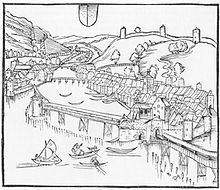
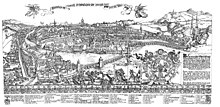




Place name
The earliest known mentions of the place are ad monasterium Lucernense or ad Lucernense monasterium (9th century; copy around 1200), monasterium Luciaria (840) and in quodam loco, qui Lucerna ex antiquitate est dictus (853; copy from the 11th century). The meaning is unclear. Suggested derivations from the Latin lucerna "lamp" (compare to this day "city of lights Lucerne"), from the Celtic god Lugus and from the male personal name Luz or Luzius are not tenable. A possible basis, however, remains the Latin lūcǐus "pike", combined with the widespread suffix -ārǐa . The meaning of the name Lucerne would therefore be “a place where pike can be found in large numbers”.
Early days and city foundation (around 750-1386)
After the fall of the Roman Empire , Germanic Alemanni took increasingly greater possession of this area from the 7th century. The Alemannic language gradually replaced the Latin . 710 was created by a Carolingian the founding Benedictine monastery St. Leodegar (there today Church of St. Leodegar ), the mid-9th century under the rule of the Alsatian abbey Murbach arrived. At that time, or around 750, the area was called Luciaria . The bailiwick of Murbach and thus also of Lucerne had been owned by the noble family of the Habsburgs since 1135 . The city was probably founded by the von Eschenbach brothers , who at the end of the 12th century held the abbot dignity of Murbach and Lucerne at the same time. The exact year the city was founded is unknown, but it must be between 1180 and 1200. The city became more and more important as a key point in the growing Gotthard traffic and as an administrative center. In 1250 Lucerne reached the size that it maintained until the 19th century. In the 13th century, Lucerne was marked by party battles between supporters of the emperor and the pope and already seemed to have had municipal self-government with a council and a citizens' assembly. In 1291, the German King Rudolf I von Habsburg acquired the rulership rights of the Murbach Monastery over Lucerne, after he had already systematically bought up the surrounding areas.
The disputes over the German royal throne 1314–1325 also led to hostilities in the countries around Lake Lucerne. In order to stabilize the situation, Lucerne entered into a union with the three neighboring forest sites of Uri , Schwyz and Unterwalden in 1332 . This federation was not directed specifically against the Habsburgs: Lucerne expressly reserved its obligations to the rule of Austria.
From the second half of the 14th century in particular, Lucerne successfully began to strengthen its influence in the surrounding rural areas and to bind sovereign rights to itself. This expansive territorial policy, which was also promoted by other federal cities such as Zurich, inevitably led to conflicts with the rule of Austria and culminated in the Battle of Sempach in 1386 . The victory of the federal parties allowed Lucerne to consolidate the territory that was already roughly the same size as today's Canton of Lucerne.
From city to city-state (1386–1520)
1415 Luzern received from Emperor Sigismund the realm of freedom and was thus up to the Peace of Westphalia in 1648 an imperial city . Lucerne formed a strong link in the Swiss Confederation. The city expanded its territorial domination, raised taxes and put civil servants bailiffs one. The city's 3,000 population decreased by about 40 percent. This was due to the plague (around 1350, in several waves) and several wars (so-called Ennetbirgische campaigns ). After the persecution of witches had initially spread mainly in the francophone-speaking area, the term "Hexereye" appeared in 1419 in a sorcery trial against a man in Lucerne and thus for the first time in the German-speaking area.
Suburb of Catholic Switzerland (around 1520–1798)
In the growing Confederation of States , Lucerne was one of the most influential cities. When the Reformation split the Confederation after 1520, most of the cities were reformed, but Lucerne remained Catholic. After the victory of the Catholics over the Reformed in the Battle of Kappel in 1531, the Catholic towns dominated the Confederation. Despite the military victory in the First Villmerger War in 1656, the balance shifted in favor of the Reformed cities such as Zurich, Bern and Basel, which defeated the Catholics in the Second Villmerger War in 1712. Lucerne's leading position in the Swiss Confederation was thus over. In the 16th and 17th centuries, wars and epidemics became increasingly rare, the population increased strongly, especially in the countryside, while the city barely grew within the walls.
Century of Revolutions (1798-1914)
In 1798, nine years after the beginning of the French Revolution , the French army invaded Switzerland. The old Confederation disintegrated and the rule of the patricians was transformed into a democracy , the Helvetic Republic emerged , the capital of which was Lucerne for a short time.
The industrial revolution came late in Lucerne. In 1860, only 1.7 percent of the population worked at home or in factories, only a quarter as much as in the rest of Switzerland. Agriculture, with a high proportion of 40 percent of the workforce in the peasant class, shaped the canton. Nevertheless, the city attracted a number of industries, but these settled in the communities around Lucerne. From 1850 to 1913 the number of the population quadrupled and their settlement area increased. The railways followed from 1856, first to Olten and Basel , in 1864 to Zug and Zurich and in 1897 to the south.
From 1910 to 1912, the Ville de Lucerne, an airship for passenger tours , operated in Lucerne . The landing area with the hall and a gas power plant was in Tribschenmoos.
Development accents in the 20th century (1914–2000)
In the 20th century the suburbs became more and more important. The population in the surrounding metropolitan area doubled, while the urban population increased only slowly. In 1981 the connection to the A2 motorway followed .
Development in the 21st century (from 2001)
On June 17, 2007, the residents of Lucerne and Littau voted for a municipal merger between Littau and Lucerne. In Lucerne, 9,869 of those entitled to vote voted for the merger, 8,875 against (53% versus 47%, participation 46.2%). The people of Littau voted for the merger with 2824 against 2343 (55% to 45%, participation 60.4%). The merger was completed on January 1, 2010. The "new" city will continue to be called Lucerne and will retain the old city arms. The population is now around 75,000.
The Lucerne city council saw this as only the first step towards further mergers. In November 2011, Ebikon , Adligenswil and Kriens decided against a merger. In March 2012, the voters of Emmen rejected the start of merger negotiations with the city of Lucerne in a referendum.
population
In the first modern census in 1798, the city of Lucerne counted 4,314 and Littau 668, i.e. 4,982 people in today's city limits. By 1950, both parts of the community grew enormously. Littau from 668 to 5644 inhabitants (+745%) and the old city area from 4314 to 60,526 people (+1303%). There are clear differences: Littau grew relatively steadily, while the city of Lucerne already experienced a tremendous development in the second half of the 19th century due to increasing tourism. This and the very good development of the city by rail and the central function as the canton capital triggered a large immigration. By 1975 the population of the core city had grown to almost 75,000 people. The rural exodus was then replaced by urban exodus. Inhabitants often moved to newly built districts in the agglomeration communities of Horw , Kriens , Emmen , Littau , Ebikon , Adligenswil , Meggen , Neuenkirch , Buchrain as well as Root and Dierikon . In the 25 years up to 2000, the core city of Lucerne lost a third of its population. The opposite happened in Littau. Between 1950 and 1980 the number of inhabitants increased from 5,644 to 14,966 (1950–1980: + 165.2%). The steady increase in population continued until the merger of Littau with the city of Lucerne at the end of 2009. Even if at a slower pace than before (1980–2009: + 15.1% or + 2258 people). Since 2000, the population has stabilized within the old urban area (2000: 59,496 inhabitants; at the end of 2009 59,509 inhabitants). The population growth in the city of Lucerne in recent years (77,198 at the end of 2010, 81,592 at the end of 2016) is taking place in all urban districts. A return movement from the agglomeration to the city center has started.
The following table shows the different population developments in the core city of Lucerne and the former municipality of Littau:
| Distribution of the population of the city of Lucerne | ||||||||||||||
| 1798 census | 1850 census | 1900 census | 1950 census | 1970 census | 1990 census | 2000 census | ||||||||
| number | proportion of | number | proportion of | number | proportion of | number | proportion of | number | proportion of | number | proportion of | number | proportion of | |
| TOTAL | 4982 | 100% | 11,382 | 100% | 32,954 | 100% | 66,170 | 100% | 83,374 | 100% | 76,466 | 100% | 75,425 | 100% |
| old urban area | 4314 | 86.59% | 10,068 | 88.46% | 29,255 | 88.78% | 60,526 | 91.47% | 69,879 | 83.81% | 61,034 | 79.82% | 59,496 | 78.88% |
| Littau | 668 | 13.41% | 1314 | 11.54% | 3699 | 11.22% | 5644 | 8.53% | 13,495 | 16.19% | 15,432 | 20.18% | 15,929 | 21.12% |
The general population development within today's limits is shown in the table below:

Sources: 1798–1837: Helvetic and cantonal censuses; Federal Office for statistics; 1850 to 2000 census results, 2010 STATPOP; today's municipal boundaries
Religions
Denomination statistics
With a total population of 81,401 at the end of 2017, 39,902 (49.0%) residents were members of the Roman Catholic Church and 9,201 (11.3%) residents were members of Evangelical Reformed churches .
Exact membership figures for other religious communities in Lucerne have not been available since the 2000 census. However, the Federal Statistical Office (FSO) carries out sample surveys that cover other religious communities in the city of Lucerne. In 2017, 6.1% of respondents aged 15 and over in Lucerne stated that they were members of another Christian church (neither Catholic nor Reformed), 4.4% were Muslim and 2.6% belonged to other religious communities. The statistical confidence interval of the individual results is between 13% and 20%.
Origin - nationality
The number of residents in the city of Lucerne was 81,401 at the end of 2017. 61,616 Swiss nationals and 19,785 nationals of other countries and stateless persons (24.31%) were among them. The ten largest groups of migrants come from:

Other nations with more than a hundred citizens are Macedonia (393 people), China (392 people), Turkey (358 people), Great Britain (338 people), Hungary (238 people), the United States (235 people), the Netherlands ( 232 people), France (216 people), Brazil (207 people), Poland (204 people), Syria (188 people), Thailand (187 people), Sweden (172 people), India (162 people), Slovakia (157 people) People), Somalia (154 people), Russia (149 people), Vietnam (139 people), Romania (138 people), Afghanistan (135 people), Greece (130 people), the Czech Republic (111 people) and Slovenia (110 people) . Nationality is unclear for 21 people and two people are stateless.
The Lucerne quarters have different proportions of foreigners (from Littauerberg 1.7% to BABEL 55.7%) and are also very different in terms of their countries of origin.
Infrastructure
See also: List of street names in Lucerne
traffic
Both the city and the agglomeration of Lucerne can be reached by public transport - by rail, road and ship.
The Swiss Federal Railways , Zentralbahn , SOB and BLS AG are the partners in rail transport (long-distance transport, regional transport and Lucerne S-Bahn ). On the road, the Lucerne public transport company (vbl) provides access to the city and the surrounding area with trolleybuses , which replaced the former Lucerne tramway , and various bus lines. Other bus lines are operated by the transport companies Auto AG Rothenburg , Rottal AG and PostBus Switzerland. After all, various communities are connected to Lucerne through the Lake Lucerne Shipping Company (SGV). All of these companies act as partner companies on behalf of the Verkehrsverbund Luzern (VVL). The various lines are put out to tender at regular intervals.
On December 11, 2004, the first phase of the Lucerne S-Bahn was opened with six new stops, a consolidation of the timetable - often every half hour - and new rolling stock. There are four train stations in the city: the train stations in Lucerne and Luzern Verkehrshaus , the train station in Littau and, since December 9, 2012, the underground train station in Lucerne Allmend-Messe, which is served by the Zentralbahn.
The pier, which connects the old town and new town, is one of the busiest roads in Switzerland.
The city is crossed by the A2 in a north-south direction (partly in tunnels) . The Reussport tunnel is one of the busiest sections of the motorway in Switzerland. Entrances and exits are (from north to south) Emmen-Süd , Luzern-Zentrum , Luzern-Kriens and Luzern-Horw . Emmen-Süd opens up the districts in the north of the city, while Kriens and Horw are more important for some southern districts than the Lucerne-Zentrum exit.
In Lucerne there is the cycle track open track between Kriens-Nidfeld and Neubad, which was built on the former route of the Zentralbahn .
A through station is being planned as an underground station for Lucerne's main station. The planning should be completed by 2026 , if it then comes to construction, an opening would be planned in 2040 .
A plan for an underground Lucerne metro was rejected in a referendum in February 2020.
education
The University of Lucerne was founded in 2000 as the youngest of the ten Swiss universities with the three faculties of theology, cultural and social sciences and law. In autumn 2016, it was expanded to include an economics faculty. Lucerne is also the headquarters of the Lucerne University of Applied Sciences and Arts (HSLU) with its six departments of Design & Art, Music, Social Work, Technology & Architecture, Business and Computer Science. In addition, Lucerne is the location of the PH Lucerne ( Lucerne University of Education) with the center for human rights education . Institutions such as the media training center , the higher technical school for social pedagogy (hsl), the Swiss Hotel Management School Lucerne (SHL), the Richemont technical school (bakery, pastry shop and confectionery) or the schools for higher cadre training of the Swiss Army (HKA) round off this Offer from Lucerne as an educational location.
health
The Lucerne Cantonal Hospital with 15 hectares in the city of Lucerne is the largest central hospital in Switzerland. The hospital center is one of the tallest buildings in Lucerne. From the Lucerne location, the whole of Central Switzerland is coordinated by the emergency services ( emergency number 144). In addition to intercantonal cooperation with the Sursee and Wolhusen locations , the Lucerne Cantonal Hospital is the hub for other cantonal hospitals in Central Switzerland, in particular the Nidwalden Cantonal Hospital .
There is also the Hirslanden Klinik St. Anna in the city .
Both hospitals have various subsidiaries spread across the city.
politics
Grand City Council (legislature)
The concerns of the population are represented by the Grand City Council. It consists of 48 members. The city council holds its meetings on Thursdays in the town hall (Rathaussaal). He is elected every four years using proportional representation - the last time on March 29, 2020.
This is how the parliament is composed:
| Political party | 2004 | 2009 | 2012 | 2016 | 2020 | |
|---|---|---|---|---|---|---|
| SP | 14th | 10 | 11 | 13 | 13 | |
| Green | 7th | 7th | 6th | 6th | 9 | |
| FDP | 8th | 9 | 9 | 9 | 9 | |
| CVP | 8th | 10 | 9 | 7th | 6th | |
| SVP | 9 | 7th | 7th | 7th | 5 | |
| glp | 0 | 3 | 4th | 4th | 4th | |
| Young Greens (JG) | 1 | 1 | 1 | 1 | 2 | |
| JUSO | 0 | 1 | 1 | 1 | 0 | |
| Chance21 | 1 | 0 | 0 | 0 | 0 |
City Council (Executive)
The Lucerne City Council consists of five full-office members. The city council is elected every four years by majority vote, most recently on March 29, 2020 with a by-election on June 28, 2020.
Since September 1st, 2016 the city council consists of:
- Beat Züsli ( SP ), City President (and thus Head of the City Chancellery) and Education Directorate, in office since 2016
- Adrian Borgula (Greens), Environment, Transport and Security Directorate, in office since 2012
- Manuela Jost (glp), building director, in office since 2012
- Martin Merki (FDP), social director, in office since 2012
- Franziska Bitzi Staub (CVP), Finance Director, in office since 2017 (replacement on November 27, 2016 for Stefan Roth )
and Michèle Bucher, city clerk , in office since 2020
National elections
In the Swiss parliamentary elections in 2019, the share of the vote in the city of Lucerne was: SP 25.0%, Greens 20.8%, SVP 15.0%, CVP 14.1%, FDP 12.9%, glp 10.5%.
Town twinning
Lucerne has partnerships with the following cities:
-
 Guebwiller / Murbach, France , since 1978
Guebwiller / Murbach, France , since 1978 -
 Bournemouth , United Kingdom , since 1982
Bournemouth , United Kingdom , since 1982 -
 Cieszyn / Teschen, Poland , since 1992
Cieszyn / Teschen, Poland , since 1992 -
 Olomouc , Czech Republic , since 1992
Olomouc , Czech Republic , since 1992 -
 Chicago , United States , since 1998
Chicago , United States , since 1998 -
 Potsdam , Germany , since 2002
Potsdam , Germany , since 2002
Coat of arms and flag
The coat of arms of Lucerne goes back to the flag. However, the flag showed the colors in a horizontal arrangement, and the arrangement was reversed. Blue is on the right in the coat of arms, so the shield is “split by blue and silver” while the flag is “split by white and blue”. The white color is at the top of the flag, the blue at the bottom. Today the canton and city have the same coat of arms, with the city adding a golden wall crown and, in the detailed variant, two golden lions as shield holders to distinguish them. The municipality of Cossonay in the canton of Vaud has the same coat of arms as Lucerne.
The oldest representation of the coat of arms of Lucerne is the seal from 1386, which shows the coat of arms with the martyrdom of Saint Leodegar . The oldest known use of the colors blue and white for Lucerne can be found in the strings on the seal of the citizens on the jury's letter 1252. A depiction of the coat of arms and flag from the 15th century has also been preserved on the Schirmer Tower in Lucerne. The origin of the colors is not known. It is assumed, however, that blue refers to the lake or Maria. The colors could also come from the ministerial families of Hunwil and Littau. Until the 17th century, the coat of arms of Lucerne showed a three-pass Lucerne / Reich with a crown. Lions with orb and sword served as shield holders. Alternatively, the city patrons Leodegar and Mauritius are often shown.
environmental Protection
Lucerne has been an energy city since 1999 and an energy city gold since 2009. The districts of Kleinstadt, Neustadt and Tribschen are to be developed using lake water heat in 2022 and 2023 . The See-Energie-Zentrale on Inseliquai and the network are to be built and operated by EWL Luzern . Customers can then extract the heat on site with a heat pump. Later, the right bank of the lake will also be developed via an extension. The Inseliquai marine energy system is expected to supply around 3,700 households with heating and cooling when it is completed. This corresponds to an amount of energy of 30 gigawatt hours per year. Thanks to the thermal energy from the lake, according to EWL, up to 5,500 tons of CO₂ can be saved annually. In the future, the Littau district will largely be supplied with district energy from waste heat from the Renergia waste incineration plant. By 2040 , most of the city's public buses are expected to run on renewable energies. The heating requirement in apartments alone causes an average of two tons of CO₂ emissions per capita per year, which is above the cantonal average of 1.7 tons.
Culture
As the venue for concerts, especially classical music, the KKL plays an important role throughout Switzerland. The residence orchestra of the KKL is the Lucerne Symphony Orchestra . Lucerne has three larger theaters, these are the Lucerne Theater , the Small Theater Lucerne and the Theater Pavilion . In addition to the main building, the Lucerne Theater has a second performance location, the "UG" in Winkelriedstrasse.

The new pool, which was created from an interim use of the former indoor pool in Lucerne, is particularly used for the alternative culture . The Sedel Music Center , which offers events in the fields of punk and rock, has existed in the former Sedel prison since 1981 . The Treibhaus Luzern appeals to a more adolescent audience . Another concert stage is available with the Konzerthaus Schüür . In the Jazzkantine Luzern , mostly students from the local music academy play in front of an audience. In addition, concerts by mainly Swiss stars take place in the Stadtkeller music restaurant . The city has 13 movie theaters in five cinemas. The Kornschütte is located in the Lucerne Town Hall. A room is available there six times a year for exhibitions from Lucerne's cultural life. There are often art exhibitions.
Events
- The Lucerne Carnival lasts from Dirty Thursday to Güdis Tuesday. It is the largest annual event in Central Switzerland.
- The Lucerne Festival , held for the first time in 2009, is the amalgamation of the former events Lucerne Old Town Festival and Lake Night Festival .
- Fumetto : Annually in the spring instead-find comics festival .
- Lucerne Blues Festival : One of the world's most important blues festivals, held in and by Lucerne residents since 1995 and has received a wide variety of prizes (for example, in 2006 the “Keeping The Blues Alive” award, which was presented outside the United States for the first time in history).
- Lucerne Festival (formerly Musikfestwochen ): One of the most important European festivals for classical and new music, known for guest concerts by the world's best symphony orchestras in the KKL .
- Blue Balls Festival : Every year in July, music festival with around 100,000 visitors for nine days. With open-air concerts around the Lucerne lake basin as well as concerts in the culture and congress center and in the Hotel Schweizerhof Luzern . The festival includes blues, jazz, soul, rock and pop as well as singer-songwriter.
- Funk am See: A free open air event that takes place every two years, at even numbers of the year, on the Lido meadow in front of the Verkehrshaus in Lucerne. In addition to rock and pop acts, there are always hip-hop acts on site.
- Rowing World Lucerne: International rowing regatta that is held annually as part of the Rowing World Cup and takes place at the beginning of July on the Rotsee .
- Top athletics Lucerne: Annual, international athletics meeting.
- Lucerne City Run : Annual running event through the new and old town.
- Lucerne Marathon : Third largest marathon in Switzerland
- LUGA (Lucerne Industrial Exhibition): Fair on the Lucerne Allmend
- PinkPanorama: Lucerne Film Festival
The largest television entertainment festival, Rose d'Or, took place annually in Lucerne from 2004 to 2012. At this festival founded in Montreux , the best international television formats are awarded the "Golden Rose". The award ceremony has been taking place in Berlin since 2014 .
Specialties
Many culinary specialties come from Lucerne, such as the pear pear , Lucerne gingerbread , Lucerne chügelipastete (meat pie, also called fritschipastete ). Local pâtissiers create new specialties such as Lozärner Rägetröpfli (chocolate praline) or the Lozärner Chatzestreckerli .
public holidays
October 2nd is a public holiday in the city in honor of St. Leodegars .
Sports
The FC Luzern playing in the Super League , the highest Swiss Football League , and is since 2011 Swissporarena home. The club previously played in the Allmend stadium . The FC Luzern women also plays in the top league, the National League A is called. There is also the FC Kickers Luzern .
The HC Luzern plays in the Regional League , the fourth-highest Hockey -Liga. In field hockey is Lucerne Sports Club Hockey active.
With the See-Club Luzern and the Rowing Club Reuss Luzern there are two rowing clubs in the city. There is also a basketball club , the Lucerne Eagles , a dance sport club , the Rock'n'Roll Club Sixteen Lucerne , as well as the Rugby Club Lucerne , a rugby union club.
Attractions
Lucerne is a frequent stop within Switzerland for group trips, especially from Asia and guests from the USA. The group travelers (around 1.4 million day visitors per year) concentrate on the Lion Monument - Schwanenplatz (with the watch and jewelry shops) - Chapel Bridge . Luzern Tourismus AG is subsidized by the city of Lucerne with an annual CHF 550,000 . According to forecasts, all tourism should reach twelve million daily visitors per year by 2030.
Historical

-
Chapel Bridge with Water Tower
- Since the city is divided by the Reuss, it has several bridges that connect the old town with the new town. The most famous of these is the Chapel Bridge from 1365. It is the oldest surviving and, at 202 meters, the second longest covered wooden bridge in Europe. In 1993 a fire destroyed most of the bridge. Since this had been extensively renovated in the 1960s and every single wooden component was registered, it could be rebuilt true to the original after the fire. Of the original triangular paintings from the early 17th century, which were installed along its entire length in the gable of the bridge, 81 of 111 were irredeemably destroyed in the fire. In the middle of the bridge is the landmark of Lucerne, the water tower with an octagonal floor plan. Both the bridge and the tower formed part of the city fortifications. That is why the wooden railings are higher on the side of the water tower.
- Old town
- Town hall (built 1602–1604, late Renaissance)
- Chaff bridge
- Musegg Wall and Musegg Towers (built 1350–1403 as a northern fortification wall)
- Ritter'scher Palast , Renaissance palace with a three-story arcade courtyard, built from 1556 for the Lucerne mayor Lux Ritter, seat of the Lucerne Jesuit College from 1577 to 1773, main building of the cantonal government since 1804. On the second floor of the arcade courtyard, there are seven large-format oil paintings with an artistic dance of death cycle. It was created between 1610 and 1615 by the Lucerne painter Jakob von Wyl (also von Wil). The panel painting added today as the eighth picture («Ossuary Concert» in portrait format) probably belonged to a lost dance of death from the neighboring Franciscan monastery.
- Lion monument after Bertel Thorvaldsen (1819)
- Needle Weir (1860)
- The Château Gütsch , a hotel completed in 1888 in the style of historicism , is one of the city's landmarks. A general renovation planned for 2012 has been delayed several times.
- Five SGV paddle steamers , the world's largest active fleet of steamers on fresh water.
- The Matthäuskirche is an important witness of the neo-Gothic .
- The Jesuit Church is the oldest large baroque church in Switzerland.
- The abbey district in the courtyard.
- The Hofkirche St. Leodegar im Hof is the most important Renaissance church building in Switzerland.
- At the Schweizerhofquai and the Nationalquai , the Kursaal (today Grand Casino) and the noble hotels Schweizerhof , National and Palace Luzern were built during the Belle Époque .
- The Peterskapelle with interior decoration in the Nazarene style .
- The Gotthard building is the most representative neo-renaissance building in the canton of Lucerne.
- The Bourbaki panorama is one of the few remaining large panoramas.
- The Anderallmend House as one of the structural landmarks of the city of Lucerne.
- The St. Anna monastery on the Gerlisberg.
- The Franciscan Church
- Steinhof Castle (built 1759–1777 by Jakob Anton Thüring von Sonnenberg). The baroque palace building is one of the most important secular buildings in Lucerne.
Museums
- Swiss Museum of Transport : the largest and most visited museum in Switzerland with a large collection of locomotives , automobiles , ships and airplanes . Among other things, the Verkehrshaus houses the only IMAX cinema and the only large planetarium in Switzerland. It also contains the Swissarena , a 200 m² walk-through aerial map.
- Bourbaki panorama : specially built panorama building with the 112 × 10 m round picture by Edouard Castres (1881)
- Rosengart Collection : Works by Pablo Picasso , Paul Klee and Modern Art, formerly Picasso Museum
- Richard Wagner Museum Tribschen, Wagner's roomsand collection of classical musical instruments. The country house in an idyllic location on Lake Lucerne regularly hosts music and poetry evenings.
- Hans Erni Museum : The museum of the famous Lucerne painter Hans Erni in the SwissMuseum ofTransport.
- Lucerne Art Museum
- Alpineum Lucerne: 3D Alpine panorama / diorama
- Glacier Garden : Lucerne during the Ice Age 20,000 years ago and in the subtropical climate 20 million years ago, right next to the Lion Monument
- Historical museum : History can be experienced vividly and up close in the depot.
- Lucerne Natural History Museum : The many special exhibitions show the flora and fauna of Central Switzerland.
Modern architecture
- Central and University Library Lucerne by Otto Dreyer (1951)
- Culture and Congress Center Lucerne (KKL) by French architect Jean Nouvel (1999), right on the lake shore
- Train station created by architects Ammann + Baumann, Santiago Calatrava helped design the main facade (1991)
- The Hotel , a hotel designed by Jean Nouvel with a restaurant and bar at Sempacherstrasse 14
- Apartment building Schönbühl by Alvar Aalto (1965–1968)
Sights in the area
- The Pilatus : the former Lake Pilatus on the hill of Lucerne to the final resting place of according to legend, Pontius Pilate to be and the ascent was, therefore, in the Middle Ages strictly prohibited. Today the mountain is accessible to tourists from both sides: from the Alpnach side with the steepest cogwheel railway in the world and on the Lucerne side with a panorama gondola and a cable car.
- The Rigi : It is called the “Queen of the Mountains” and owns the first mountain railway in Europe.
- The Lucerne has five steamers ( Uri , Lucerne , Unterwalden , Gallia and Schiller ), the largest steamer fleet in Switzerland.
sons and daughters of the town
Other personalities
- Alfonso Casati (* 1565 in Milan , † August 21, 1621 in Lucerne), envoy of Spain to the Catholic towns of the Swiss Confederation in Lucerne
gallery
Court Church in March 2007
Concert hall of the KKL Luzern ( World Band Festival Luzern 2012)
literature
- Ebbe Nielsen, Hermann Fetz, Konrad Wanner, Markus Trüeb, Markus Lischer: Lucerne (municipality). In: Historical Lexicon of Switzerland .
- Andreas Bürgi: A tourist picture factory. Commerce, pleasure and instruction at Lucerne's Löwenplatz, 1850–1914 . Chronos Verlag, Zurich 2016, ISBN 978-3-0340-1296-6 .
- Heinz Horat: Lucerne, town hall. (Swiss Art Guide GSK, Volume 301). Bern 1981, ISBN 3-85782-301-1 .
- Paul Letter: History and Culture of Lucerne. Beginnings and developments of a canton capital . Frieling, Berlin 2002, ISBN 3-8280-1759-2 .
- Dominik Riedo (Ed.): Luzern, Luzern… Literary traces. A reader . Pro Libro, Lucerne 2011, ISBN 978-3-905927-16-0 .
- Peter Schnider: Factory industry between agriculture and tourism. Industrialization of the Lucerne agglomeration between 1850 and 1930 . Rex Verlag, Lucerne 1998.
- Dominik Sieber: Jesuit missionary work, priestly love, sacramental magic. Folk cultures in Lucerne 1563–1614 . Schwabe, Basel 2005. ISBN 3-7965-2087-1 .
- Leo Tolstoy : From the diary of Prince Nekhludov: Lucerne - travel report.
- Mark Twain : A Tramp Abroad (German stroll through Europe ). - The travelogue contains a detailed, satirical description of Lucerne. - Link to the full text on Project Gutenberg
Web links
- Official website of the city of Lucerne
- Lucerne Tourism website
- Community profile of the cantonal statistical office (PDF; 109 kB)
- Photo gallery of the Photo Documentation Foundation of the Canton of Lucerne (photo document)
- Lucerne city view by Martin Martini 1597
- Plan of the city of Lucerne from 1790 by Franz Xaver Schumacher
- Roger Brunner and Paolo Hendry: Quality of life in the neighborhoods. The Lucerne neighborhood and district policy against the background of spatial identity and political control options - basic report for the further development of the district and district policy in Lucerne . Master's thesis, 2009 (PDF; 1.7 MB)
References and comments
- ↑ Permanent and non-permanent resident population by year, canton, district, municipality, population type and gender (permanent resident population). In: bfs. admin.ch . Federal Statistical Office (FSO), August 31, 2019, accessed on December 22, 2019 .
- ↑ Permanent resident population by nationality category, gender and municipality ( memento from January 1, 2015 in the Internet Archive ) (permanent resident population)
- ↑ wira statistics, unemployed by constituency (pdf)
- ↑ Beat Züsli replaces Stefan Roth as Mayor of Lucerne ( Memento from June 5, 2016 in the Internet Archive )
- ↑ Felix Blumer: Records in January - records for temperature and sunshine duration. In: srf.ch . February 1, 2020, accessed February 4, 2020 .
- ↑ Infra municipal units: urban districts and neighborhoods of the city of Lucerne. In: lustat.ch. Statistics Lucerne, accessed on March 22, 2016 .
- ↑ a b FSO codes for quarters ( memento of June 20, 2013 in the Internet Archive ) (Federal Statistical Office FSO), accessed on January 12, 2012
- ↑ Lexicon of Swiss municipality names . Edited by the Center de Dialectologie at the University of Neuchâtel under the direction of Andres Kristol. Frauenfeld / Lausanne 2005, p. 558.
- ^ Editing HLS: Luzern (Canton). In: Historical Lexicon of Switzerland . February 7, 2018 , accessed June 4, 2019 .
- ^ Stefan Jäggi: Sempach War. In: Historical Lexicon of Switzerland . December 18, 2012 , accessed June 4, 2019 .
- ↑ RI XI n.1616 , RI XI n.1618 , 1619 , 1620
- ↑ Heike Albrecht: Hexenglauben, witch hunt, witch madness in Germany in the early modern period. Sociological Analysis Approach. Master's thesis, Diplomica-Verlag, p. 80 ( Google Books ) - with references.
- ↑ Population by nationality and gender since 1860
- ↑ Source: Robert Gubler, Population Development and Economic Changes in the Canton of Lucerne, Conclusion Table 1
- ↑ Permanent resident population by denomination in 2017 (absolute). LUSTAT Statistics Lucerne, November 28, 2018, accessed on October 1, 2019 .
- ↑ Permanent resident population by denomination in 2017 (in percent). LUSTAT Statistics Lucerne, November 28, 2018, accessed on October 1, 2019 .
- ↑ For the first time in 2017, Catholics from Lucerne were in the minority
- ↑ Since 2010, the FSO's data on the religious communities in Lucerne have been based on a sample survey for which people aged 15 and over are surveyed. (See census in Switzerland # structural survey .) Since the last census in 2000, there are no more figures on the religious affiliation of the total population (of all ages). Exceptions are the Roman Catholic and Evangelical Reformed Churches, whose members are officially registered due to the church tax.
- ↑ Permanent resident population aged 15 and over by religious affiliation, by canton and city. ( XLSX ) FSO, January 29, 2019, accessed October 2, 2019 .
- ↑ Balance of the permanent resident population according to demographic components, institutional structure and nationality (Federal Statistical Office, STAT-TAB)
- ^ Inhabitants and nationality in the city districts
- ↑ Foreign population by nationality in the city districts
- ↑ "The construction of the through station is an open-heart operation." In: Luzerner Zeitung , July 6, 2019
- ↑ Lucerne underground station
- ↑ Roman Hodel: A bus hub over the platforms? In: Luzernerzeitung.ch. June 21, 2019, accessed June 19, 2019 .
- ↑ https://m.srf.ch/news/schweiz/abstektiven-oberrubrik/abstimmen/stadt-luzern-nein-zum-metro-projekt
- ↑ Lucerne Cantonal Hospital. March 29, 2018, accessed on May 5, 2019 (Swiss Standard German).
- ↑ Hirslanden Klinik St. Anna, Lucerne. Retrieved May 5, 2019 .
- ↑ City of Lucerne - Elections and Votes - Results of June 16, 2009 ( Memento of December 20, 2010 in the Internet Archive )
- ↑ Elected and unelected, party and candidate votes, number of seats ( Memento from August 7, 2011 in the Internet Archive )
- ↑ New election of the Grand City Council on May 1, 2016 ( Memento from May 31, 2016 in the Internet Archive )
- ↑ Local elections 2020 - Canton of Lucerne. Retrieved April 14, 2020 .
- ^ The City Council of Lucerne ( Memento of December 21, 2009 in the Internet Archive )
- ↑ Federal elections 2019 | opendata.swiss. Retrieved November 24, 2019 .
- ^ Sister cities of the City of Lucerne ( Memento from June 21, 2013 in the Internet Archive ) Official website of the City of Lucerne
- ↑ Coat of arms of the city of Lucerne (.gif / .tif format, color). City of Lucerne, November 10, 2009, archived from the original on March 28, 2015 ; accessed on January 15, 2015 .
- ^ Louis Mühlemann: Coats of arms and flags of Switzerland. Zurich 1980, p. 45f.
- ↑ Energy City. Media release of the city administration. Retrieved on July 19, 2019 (Swiss Standard German).
- ↑ Lucerne (EnergieSchweiz). Retrieved July 19, 2019 .
- ↑ a b Sea Energy. Retrieved July 19, 2019 .
- ↑ The ecological sea energy network in Lucerne is growing - construction work at Inseliquai. Retrieved October 30, 2019 .
- ↑ LUCERNE: 3 million francs from the city to the district heating development in Littau. Retrieved July 19, 2019 .
- ↑ Simon Mathis, Simon Mathis: An e-bus from Bern visiting Lucerne. Retrieved July 19, 2019 .
- ↑ Construction, Environment and Economics Directorate of the Canton of Lucerne: Municipality of Energiespiegel Luzern. (PDF; 1.3 MB) November 2019. Accessed January 11, 2020 .
- ↑ Blue Balls Festival - Official website of the Blue Balls Festival
- ↑ Rowing World Lucerne
- ↑ About the Rose d'Or , rosedor.com; Accessed November 1, 2017
- ↑ Lucerne tourists increasingly want to go where the locals meet. In: Luzerner Zeitung , March 21, 2018
- ↑ Robert Knobel: Despite the deserted Schwanenplatz: Lucerne city parliament discusses "overtourism" . In: luzernerzeitung.ch , March 12, 2020, accessed on March 13, 2020.
- ↑ Barcelona, Venice, Lucerne - the fear of "overtourism" is growing. In: Neue Zürcher Zeitung , August 2, 2018
- ↑ Hans Georg Wehrens: The dance of death in the Alemannic language area. "I have to do it - and don't know what" . Schnell & Steiner, Regensburg 2012, ISBN 978-3-7954-2563-0 . P. 185ff.
- ↑ Start of construction at Château Gütsch article in Blick from July 16, 2012
- ^ Fabrizio Brentini: Lucerne. Abbey district in the courtyard. (Swiss Art Guide, No. 522). Ed. Society for Swiss Art History GSK. Bern 1992.
- ^ Rudolf Bolzern: Alfonso Casati. In: Historical Lexicon of Switzerland . July 31, 2003 , accessed March 12, 2020 .
